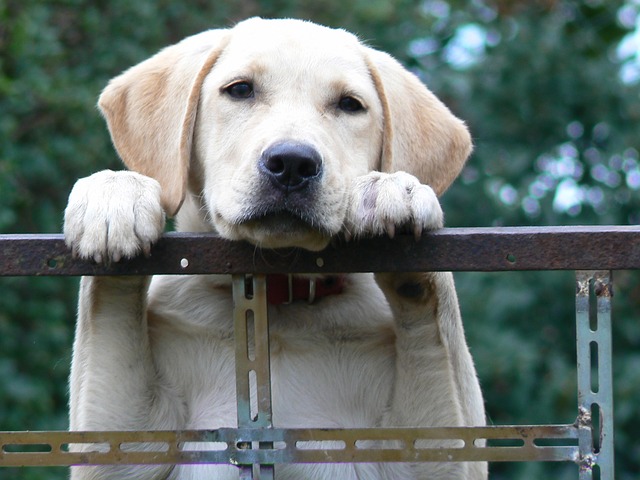Summary: Review of the best dog crate for Labs. We provide pros and cons of the major types of indoor dog crates for Labrador Retrievers and provide our top pick.
Best Dog Crate for Labs
So, you are seeking a crate to contain your high energy Labrador Retriever or you are planning to bring a puppy home and want to begin crate training him or her. Labs are the #1 most popular dog breed in America for over 2 decades according to the AKC. Labrador Retrievers have a medium requirement for exercise. So, just remember to not keep your Lab under the lock all the time. That’s why it is smart to begin searching for the best dog crate for Labs.
The AKC indicates that “Labs are very friendly dogs—perhaps the friendliest of the pack. They are easy to get along with, and socialize well with other dogs and humans alike. Still, don’t confuse his laid-back personality for low energy. The Labrador Retriever is extremely active—he’s never met a backyard he didn’t like. Since Labs enjoy playing and swimming outside, owners frequently channel their high energy on hunting and fishing outings.”
The key items to consider when buying the best dog crate for Labs includes the following:
- Where you will place the crate in your home?
- The material the crate is made from.
- The style or design of the crate.
- Slide out trays for easy cleaning.
- Portability and durability of your dog crate.
- Safety features and lack of sharp edges.
- Price.
Most Popular Crate Types for Labs
Although there are soft-sided crates, wood dog crates, plastic(travel type) crates and wire crates, the most popular type of crate for labs is the wire crates that are collapsible. They are very affordable and easily movable to relocate when necessary. They are also very easy to clean and can be indestructible in comparison to collapsible (fabric) crates or wood crates. I’m going to list some pros and cons of each crate type below.
Pros and Cons of Crate Types for Labs
Pros of Soft Sided Dog Crates for Labs
- Much quieter than metal dog crates.
- Lighter weight for ease of portability.
- Great for outings.
- Ease of storage.
Cons of Soft Sided Dog Crates for Labs
- Difficult to clean potty accidents.
- Durability can be questionable on some types of soft-sided dog crates.
Pros of Plastic Dog Crates for Labs
- Can be used for airline travel, just make sure it is FAA approved.
- More color options available.
- Have proven to be the most difficult crate type to escape from.
- Plastic bottom is easier to clean than fabric crates.
Cons of Plastic Dog Crates for Labs
- Less air circulation than cage type crates.
- Lack of visibility for dogs that get anxious when they can’t see what’s going on.
- Cannot fold flat so they take up more room when storing.
- Bottom of dog crate doesn’t slide out for easy cleaning so you may have to reach or climb in to clean.
Pros of Metal Wire Dog Crates for Labs
- Best air circulation of all crate types (important for hotter climates).
- Generally are collapsible for easy storage.
- Generally have a bottom tray that slides out for easy cleaning so you don’t have to climb in.
- Can resize the crate with a divider so you can keep the same crate from the puppy stage through adult stage saving you money.
- Allows your lab great visibility around the area.
- Can cover with a crate cover if needed.
Cons of Metal Wire Dog Crates for Labs
- Can be more noisy than the other crate types.
- Can pinch your fingers when collapsing, so pay attention.
- Doesn’t contain all animal excrement in some cases if your dog is determined if they lift their leg or such.
Best Dog Crate Size for Labs – 42 Inch Dog Crate
Labs are considered a medium sized dog breed by the AKC. So, make sure you are looking for a medium sized dog breed crate. Don’t make the mistake of buying ‘too large’ of a crate thinking you are doing your lab a service. Too large of a crate will hinder your efforts in crate training your dog. When crate training, a Labrador Retriever with too large of a crate, your Lab could use one end of the crate as a bathroom, and the other end for sleeping.
Crate size for Labs is key! A Lab needs to be able to stand straight up without hitting its head on the top of the crate. It also should be able to turn around freely in the crate. And the Labrador should also be able to lie down comfortably in its crate. Generally, most veterinarians and Labrador enthusiasts will recommend a 42 inch dog crate for Labrador Retrievers.
Reviews of Best Dog Crates for Labrador Retrievers
I’m going to review the following 2 most popular dog crates for labs on Amazon. Key differences between the two products are highlighted with bold.
- 42 Inch MidWest iCrate Folding Metal Dog Crate
- AmazonBasics 42 inch Folding Metal Dog Crate
Midwest iCrate Dog Crate with Divider for Labs, 42-Inch
MidWest iCrate Folding Metal Dog Crate Review
The key features of the 42-Inch Midwest iCrate Dog Crate for Labs include the following:
- Double doors
- Dimensions: 42L x 28W x 30H inches
- Weight: 35 pounds
- Includes free divider panel so your puppy can grow into this kennel and you don’t have to buy a smaller dog crate while he or she is a puppy.
- Leak-proof plastic pan.
- A strong carrying handle.
- Rubber feet to protect floors.
- 1 year Manufacturer’s Warranty.
- 1-800 customer service line with listed business hours.
- Easily assembles with no tools necessary.
- Two slide-bolt latches securely lock door in place.
- Dog crate folds flat for convenient storage, travel and portability.
AmazonBasics 42 inch Folding Metal Dog Crate for Labs
AmazonBasics 42 inch Folding Metal Dog Crate Review
The key features of the AmazonBasics 42 inch Folding Metal Dog Crate for Labs include the following:
- Double doors
- Dimensions: 42L x 28W x 30H inches
- Weight: 30.6 pounds
- Designed with mini dividers (1.35 cm between each bar) on bottom perimeter to prevent paws from slipping through.
- Includes free divider panel so your puppy can grow into this kennel and you don’t have to buy a smaller dog crate while he or she is a puppy.
- Leak-proof plastic pan
- Didn’t indicate if rubber feet were included to protect floors.
- Manufacturer’s Warranty wasn’t present on products page.
- Two slide-bolt latches securely lock door in place.
- Easily assembles with no tools necessary.
- Dog crate folds flat for convenient storage, travel and portability.
- No displayed 1-800 number for customer service (have you ever tried calling Amazon customer service – plan on being directed to a web page).
Best Metal Dog Crate for Labs Review Summary
If you are going to buy a folding metal dog crate for your lab, I would recommend the best dog crate for Labs is the AmazonBasics 42 inch Folding Metal Dog Crate for Labs. My reasoning is fairly simple. Customers rate both products identically. The biggest difference which sways me toward recommending the AmazonBasics dog crate are the mini dividers between each bar on bottom perimeter to prevent paws from slipping through (which is a key feature I like). Sure, there is not a listed warranty or customer service phone number, but a key safety feature I feel is more important for similar products.
The lack of rubber feet on the bottom of the AmazonBasics product doesn’t convince me to depart from my recommendation as this is easily solvable. But safety features are not. Especially, if you plan on using the divider to house a puppy. An additional plus for the AmazonBasics dog gate for labs is the overall weight of the dog crate. The AmazonBasics dog crate lists at 30.6 pounds and the MidWest dog crate lists at 35 pounds. The MidWest dog crate carries the designation on Amazon of #1 best seller in dog houses so you’ll have to decide for yourself. If you’re not worried about the mini dividers on the bottom, then go with the 42-Inch Midwest iCrate Dog Crate for Labs and save yourself a couple dollars.












